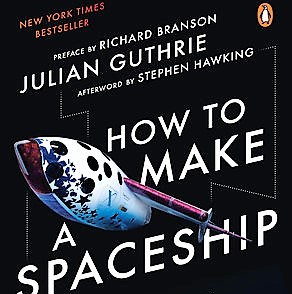How to Make a Spaceship
Editor, Grant Schlichting, reviews Julian Guthrie’s new novel about space exploration
Seventy-three seconds turned an entire industry on its head. Seven deaths switched an ideology of a large government organization from exploration to creeping red tape and safety checks. It took thirty-two months before the organization ever again reached for the stars and sent another Space Shuttle to the stars. When Challenger exploded on January 28, 1986 the Space Industry halted. At this point the federal government would no longer carry the flames to the gods as it had done so under the Apollo missions, it would now take a back seat in space exploration.
Peter Diamandis, a space junkie all throughout high school and college, realized that the United States Government would no longer be the champions of space after the Challenger crashed. And he acted, bringing Space Exploration to the private sector. How to Make a Spaceship by Julian Guthrie lays out the story of the unsung heros who continued to carry space exploration forward.
Julian Guthrie writes the riveting tale of SpaceShipOne, the first spacecraft to make it to outer space without government help. Her story starts with the lives of Diamondis and others who were influential in this process, chapter by chapter until launch. No detail was left out, no stone unturned for the writing of this book.
This history in and of itself is just one of the kernels of information that are stored away in this nonfiction masterpiece. Aviation advanced from biplanes in 1903 to flying roundtrip to the moon my 1969. In less than a generation – 66 years – mankind had advanced through an ungodly amount of information and technological change to bring about Space Travel. One reason was two world wars and a cold war the pushed aviation forward. The book also lays out the flight prizes that were also crucial in the development of flying.
The Book draws parallels to the Orteig Prize – the payment Charles Lindbergh was after to fly transatlantic from Paris to New York (Or Visa Versa) without stopping. Although the prize was only worth $25,000 in 1927, over $100,000 was spent by competitors trying to create an airplane that could cross the Atlantic.
To bring private spaceflight to reality, Peter Diamandis created his own prize – the XPRIZE – which fueled private spaceflight into the 21st Century. The $10 million dollar reward brought competitors from around the world to reach for the stars, and in 2004 it was won in the Mojave Desert by Burt Rutan and his team at Scaled Composite. Space was no longer the sole property of Government agencies; it was now run by the people.
This story is too often forgotten. The only names heard of are those of SpaceX, Virgin Galactic, and the Sierra Nevada Corporation. These names, and the $2 billion private spaceflight industry wouldn’t have started without a couple of dreamers that wanted access to space. It’s a ten out of ten, would read again book that helps mankind appreciate and understand the daunting task of spaceflight.

Taking on Tenth grade, trap shooting, speech, skiing, jazz band, band and debate keeps Grant extra busy during the school year. Plus, he's the Lantern's...

